Lunar Exploration Based on Ground-Based Radar: Current Research Progress and Future Prospects
Abstract
1. Introduction
2. Principle of GBR Observation of the Moon
2.1. Brief Description of the Current Major GBR Systems
| Transmitter Telescope | Country | Antenna Diameter (m) | Transmitter Frequency | Maximum Transmission Power | Main Applications |
|---|---|---|---|---|---|
| Arecibo | USA | 305 | 430 MHz | 150 kW | Ionosphere detection Planetary exploration |
| 2380 MHz | 1 MW | ||||
| GSSR | USA | 70 | 8560 MHz | 500 kW | Near-Earth asteroid detection, deep space exploration |
| Haystack | USA | 37 | 7840 MHz | 500 kW | Detection and imaging of space targets |
| Green Bank | USA | 100 | 5 GHz | 1 MW | High-resolution planetary surface imaging |
| Evpatoria | Crimea | 70 | 5.01 GHz | 90 kW | Space debris detection, Venus and Mars exploration |
| EISCAT-UHF | Norway | 32 | 928.4 MHz | 1.8 MW | Ionosphere detection, lunar surface imaging |
| QuJing Incoherent Scatter Radar (QJISR) | China | 29 | 500 MHz | 2 MW | Ionosphere detection, lunar surface imaging |
2.2. Principles of GBR Imaging
2.2.1. Delay–Doppler Mapping
2.2.2. Interferometric Imaging
3. GBR Imaging of the Surface/Subsurface of the Moon
3.1. Mapping of Lunar Topography and Geomorphology
3.2. Observing Thickness of the Lunar Regolith
3.3. Observations of Water Ice in the Lunar Polar Region
4. Radar Inversion of the Dielectric Properties of Subsurface Materials of the Moon
5. Development and Future Prospects of Chinese GBR
6. Conclusions and Prospects
- (1)
- Estimation of physical parameters of lunar materials: GBR has effectively estimated the physical parameters of the lunar surface and subsurface materials through the measurement of reflection and scattering characteristics. Breakthroughs have been achieved in the inversion of the thickness and dielectric properties of the lunar regolith. These studies have deepened our understanding of the shallow lunar structure and provided data support for future lunar resource development.
- (2)
- Detection of polar water ice: GBR has demonstrated unique advantages in detecting permanently shadowed regions at the lunar poles. Radar imaging and echo analysis have preliminarily revealed evidence of possible water ice in these areas. Further research is needed to determine the reserves, distribution, and extent of lunar polar water ice, which is significant for future lunar base construction and resource utilization.
- (3)
- High-resolution radar imaging: High-resolution radar imaging technology has detailed the topographic features of the lunar surface, identifying geological activities and potential resource distribution areas. These data are crucial for understanding the formation and evolution of the Moon.
- (4)
- Optimization of imaging algorithms and data processing: There is a need to further optimize existing imaging algorithms and data processing capabilities to improve detection accuracy and efficiency. Enhancing the construction of distributed aperture radar systems will help improve detection range and accuracy. Prospects include the integration and analysis of multi-source data, providing more comprehensive and precise lunar exploration information.
Author Contributions
Funding
Acknowledgments
Conflicts of Interest
References
- Ouyang, Z. Introduction to Lunar Science; China Aerospace Press: Beijing, China, 2005; pp. 1–10. (In Chinese) [Google Scholar]
- Heiken, G.; Vaniman, D.; French, B.M. Lunar Sourcebook: A User’s Guide to the Moon; Cup Archive: Cambridge, UK, 1991. [Google Scholar]
- Suonanben; Wu, F.; He, K.; Sun, S.; Zhou, W.; Zhou, M.; Zhang, C.; Xu, J.; Yan, Q.; Xu, S.; et al. The electrical design of a membrane antenna for a lunar-based low-frequency radio telescope. Astron. Tech. Instruments 2024, 1, 227–238. [Google Scholar] [CrossRef]
- Wang, R.; Xia, S. A Review of Earth-based Radar Imaging of the Moon. Radio Eng. 2023, 7, 179–198. (In Chinese) [Google Scholar]
- Campbell, B.A. Planetary geology with imaging radar: Insights from earth-based lunar studies, 2001–2015. Publ. Astron. Soc. Pac. 2016, 128, 062001. [Google Scholar] [CrossRef][Green Version]
- Neish, C.D.; Carter, L.M. Planetary radar. In Encyclopedia of the Solar System; Elsevier: Philadelphia, PA, USA, 2014; pp. 1133–1159. [Google Scholar]
- Ostro, S.J. Planetary radar astronomy. Encycl. Phys. Sci. Technol. 1987, 10, 611–634. [Google Scholar]
- Ding, C.; Feng, J.; Zheng, L.; Dai, S.; Xing, S.; Xiao, Y.; Su, Y. A Review of Applications of Radar-Detection Techniques in Lunar Explorations. Astron. Tech. Instruments 2015, 12, 228–242. (In Chinese) [Google Scholar] [CrossRef]
- Mofenson, J. Radar echoes from the moon. Electronics 1946, 19, 92–98. [Google Scholar]
- Zisk, S. Mare Crisium area topography-A comparison of earth-based radar and Apollo mapping camera results. In Proceedings of the Mare Crisium: The View from Luna 24, Houston, TX, USA, 1–3 December 1977; pp. 75–80. [Google Scholar]
- Ostro, S.; Campbell, D.; Simpson, R.; Hudson, R.; Chandler, J.; Rosema, K.; Shapiro, I.; Standish, E.; Winkler, R.; Yeomans, D. Europa, Ganymede, and Callisto: New radar results from Arecibo and Goldstone. J. Geophys. Res. Planets 1992, 97, 18227–18244. [Google Scholar] [CrossRef]
- Evans, J. Modulation, demodulation, and data processing applied to radar astronomy. In Radar Astronomy; McGraw-Hill: New York, NY, USA, 1968; pp. 499–545. [Google Scholar]
- Yaplee, B.; Bruton, R.; Craig, K.; Roman, N. Radar echoes from the moon at a wavelength of 10 cm. Proc. IRE 1958, 46, 293–297. [Google Scholar] [CrossRef]
- Green, P.; Price, R. Signal Processing in Radar Astronomy; Technical Report 234; MIT Lincoln Laboratory: Cambridge, MA, USA, 1960. [Google Scholar]
- Zisk, S. Lunar topography: First radar-interferometer measurements of the Alphonsus-Ptolemaeus-Arzachel region. Science 1972, 178, 977–980. [Google Scholar] [CrossRef]
- Zisk, S. A new, earth-based radar technique for the measurement of lunar topography. Moon 1972, 4, 296–306. [Google Scholar] [CrossRef]
- Patterson, G.; Stickle, A.; Turner, F.; Jensen, J.; Bussey, D.; Spudis, P.; Espiritu, R.; Schulze, R.; Yocky, D.; Wahl, D. Bistatic radar observations of the Moon using Mini-RF on LRO and the Arecibo Observatory. Icarus 2017, 283, 2–19. [Google Scholar] [CrossRef]
- Yakovlev, O.I.; Yushkova, O.V.; Matyugov, S.S.; Pavelyev, A.G.; Smirnov, V.M. Determination of the Lunar Ground Characteristics Using Bistatic Radar. Int. J. Geosci. 2015, 6, 1267–1276. [Google Scholar] [CrossRef]
- Sun, J.; Yang, S.; Zhou, F.; Ding, Z.; Liu, L.; Cao, J.; Han, S.; Ping, J. The Status of Earth-based Radar Astronomical Observations of the Moon in China. Astron. Tech. Instrum. 2022, 19, 29–40. (In Chinese) [Google Scholar] [CrossRef]
- Campbell, D.B.; Campbell, B.A.; Carter, L.M.; Margot, J.L.; Stacy, N.J. No evidence for thick deposits of ice at the lunar south pole. Nature 2006, 443, 835–837. [Google Scholar] [CrossRef] [PubMed]
- Campbell, B.A.; Hawke, B.R.; Thompson, T.W. Regolith composition and structure in the lunar maria: Results of long-wavelength radar studies. J. Geophys. Res. Planets 1997, 102, 19307–19320. [Google Scholar] [CrossRef]
- Campbell, B.A.; Campbell, D.B.; Margot, J.L.; Ghent, R.R.; Nolan, M.; Chandler, J.; Carter, L.M.; Stacy, N.J. Focused 70-cm wavelength radar mapping of the Moon. IEEE Trans. Geosci. Remote Sens. 2007, 45, 4032–4042. [Google Scholar] [CrossRef]
- Campbell, B.A.; Hawke, B.R.; Carter, L.M.; Ghent, R.R.; Campbell, D.B. Rugged lava flows on the Moon revealed by Earth-based radar. Geophys. Res. Lett. 2009, 36, L22201. [Google Scholar] [CrossRef]
- Fa, W.; Wieczorek, M.A. Regolith thickness over the lunar nearside: Results from Earth-based 70-cm Arecibo radar observations. Icarus 2012, 218, 771–787. [Google Scholar] [CrossRef]
- Ghent, R.R.; Leverington, D.W.; Campbell, B.A.; Hawke, B.R.; Campbell, D.B. Earth-based observations of radar-dark crater haloes on the Moon: Implications for regolith properties. J. Geophys. Res. Planets 2005, 110, E02005. [Google Scholar] [CrossRef]
- Shkuratov, Y.G.; Bondarenko, N.V. Regolith layer thickness mapping of the Moon by radar and optical data. Icarus 2001, 149, 329–338. [Google Scholar] [CrossRef]
- Jiang, S.; Shen, Y.; Xiang, W.U.; Deng, Z.; Xiaoming, L.A.I.; Zhang, J.; Liang, L.; Zhou, Q. Technical Schemes of Investigation and In-Situ Utilization for Lunar Surface Generalized Resources. J. Deep Space Explor. 2015, 2, 291–301. (In Chinese) [Google Scholar] [CrossRef]
- Tang, J.; Quan, Q.; Jiang, S.; Li, H.; Bai, D.; Tang, D.; Deng, Z. Experimental investigation on flowing characteristics of flexible tube coring in lunar sampling missions. Powder Technol. 2018, 326, 16–24. [Google Scholar] [CrossRef]
- Chin, G.; Brylow, S.; Foote, M.; Garvin, J.; Kasper, J.; Keller, J.; Litvak, M.; Mitrofanov, I.; Paige, D.; Raney, K.; et al. Lunar Reconnaissance Orbiter Overview: The Instrument Suite and Mission. Space Sci. Rev. 2007, 129, 391–419. [Google Scholar] [CrossRef]
- Crawford, I.; Anand, M.; Cockell, C.; Falcke, H.; Green, D.; Jaumann, R.; Wieczorek, M. Back to the Moon: The scientific rationale for resuming lunar surface exploration. Planet. Space Sci. 2012, 74, 3–14. [Google Scholar] [CrossRef]
- Ding, C.; Li, C.; Xiao, Z.; Su, Y.; Xing, S.; Wang, Y.; Feng, J.; Dai, S.; Xiao, Y.; Yao, M. Layering Structures in the Porous Material Beneath the Chang’e-3 Landing Site. Earth Space Sci. 2020, 7, e2019EA000862. [Google Scholar] [CrossRef]
- Zacny, K. Lunar drilling, excavation and mining in support of science, exploration, construction, and in situ resource utilization (ISRU). In Moon: Prospective Energy and Material Resources; Springer: Cham, Switzerland, 2012; pp. 235–265. [Google Scholar]
- Slade, M.A.; Benner, L.A.; Silva, A. Goldstone solar system radar observatory: Earth-based planetary mission support and unique science results. Proc. IEEE 2010, 99, 757–769. [Google Scholar] [CrossRef]
- Mathews, J. Fifty years of Radio Science at Arecibo Observatory: A brief overview. URSI Radio Sci. Bull. 2013, 2013, 12–16. [Google Scholar]
- Whitney, A.R.; Lonsdale, C.J.; Fish, V.L. Insights into the Universe: Astronomy with Haystack’s radio telescope. Linc. Lab. J 2014, 21, 8–27. [Google Scholar]
- Konovalenko, A.; Lytvynenko, L.; van t Klooster, C. Radio telescope RT-70 in Evpatoria and space investigations. In Proceedings of the 4th International Conference on Antenna Theory and Techniques (Cat. No. 03EX699), Sevastopol, Ukraine, 9–12 September 2003; Volume 1, pp. 57–62. [Google Scholar]
- Bramson, A.M.; Patterson, G.W.; Morgan, G.A.; Jozwiak, L.M.; Nypaver, C.A.; Neish, C.D.; Nolan, M.C.; O’Shea, C.; Virkki, A.K.; Taylor, P.A. Bistatic radar analysis of buried basaltic maria on the Moon. AAS/Div. Planet. Sci. Meet. Abstr. 2023, 55, 207.04. [Google Scholar]
- Wahl, D.E.; Yocky, D.A.; Bussey, B.; Jakowatz Jr, C.V. Generating lunar bistatic SAR images using Arecibo and Mini-RF. In Proceedings of the Algorithms for Synthetic Aperture Radar Imagery XIX, Baltimore, MD, USA, 2 May 2012; Volume 8394, pp. 86–89. [Google Scholar]
- Benner, L.A.; Busch, M.W.; Giorgini, J.D.; Taylor, P.A.; Margot, J.L. Radar observations of near-Earth and main-belt asteroids. Asteroids IV 2015, 1, 165–182. [Google Scholar]
- Long, T.; Ding, Z.; Zeng, T.; Dong, Z.; Li, L. Developments and Prospects of Ground-Based Deep-Space Radar. J. Signal Process. 2024, 40, 56–72. (In Chinese) [Google Scholar]
- Wang, R.; Su, Y.; Hong, T.; Dai, S.; Liu, C. A Review of Application of Surface Penetrating Radar in the Moon and Deep-space Exploration. Astron. Tech. Instrum. 2020, 17, 492–512. (In Chinese) [Google Scholar]
- Zheng, L.; Su, Y.; Zheng, Y.; Li, C.; Zhao, P. Ground-based radar technology and its applications in the exploration of solar system bodies. Prog. Astron. 2009, 27, 373–382. (In Chinese) [Google Scholar]
- Thompson, T.W. A review of Earth-based radar mapping of the Moon. Moon Planets 1979, 20, 179–198. [Google Scholar] [CrossRef]
- Hensley, S.; Gurrola, E.; Rosen, P.; Slade, M.; Jao, J.; Kobrick, M.; Wilson, B.; Chen, C.; Jurgens, R. An improved map of the lunar south pole with earth based radar interferometry. In Proceedings of the 2008 IEEE Radar Conference, Sheraton Golf Parco dei Medici, Rome, Italy, 26–30 May 2008; pp. 1–6. [Google Scholar]
- Margot, J.L.; Campbell, D.B.; Jurgens, R.F.; Slade, M.A. Digital elevation models of the Moon from Earth-based radar interferometry. IEEE Trans. Geosci. Remote Sens. 2000, 38, 1122–1133. [Google Scholar] [CrossRef]
- Pettengill, G.; Zisk, S.; Thompson, T. The mapping of lunar radar scattering characteristics. Moon 1974, 10, 3–16. [Google Scholar] [CrossRef]
- Stacy, N.J.S. High-Resolution Synthetic Aperture Radar Observations of the Moon; Cornell University: NewYork, NY, USA, 1993. [Google Scholar]
- Campbell, B.A.; Carter, L.M.; Campbell, D.B.; Nolan, M.; Chandler, J.; Ghent, R.R.; Hawke, B.R.; Anderson, R.F.; Wells, K. Earth-based 12.6-cm wavelength radar mapping of the Moon: New views of impact melt distribution and mare physical properties. Icarus 2010, 208, 565–573. [Google Scholar] [CrossRef]
- Thompson, T.W. Map of lunar radar reflectivity at 7.5-m wavelength. Icarus 1970, 13, 363–370. [Google Scholar] [CrossRef]
- Pettengill, G.; Thompson, T. A radar study of the lunar crater Tycho at 3.8-cm and 70-cm wavelengths. Icarus 1968, 8, 457–471. [Google Scholar] [CrossRef]
- Chandel, R.; Gupta, G. Image filtering algorithms and techniques: A review. Int. J. Adv. Res. Comput. Sci. Softw. Eng. 2013, 3, 198–202. [Google Scholar]
- Villar, S.A.; Torcida, S.; Acosta, G.G. Median filtering: A new insight. J. Math. Imaging Vis. 2017, 58, 130–146. [Google Scholar] [CrossRef]
- Pettengill, G.; Henry, J. Enhancement of radar reflectivity associated with the lunar crater Tycho. J. Geophys. Res. 1962, 67, 4881–4885. [Google Scholar] [CrossRef]
- Campbell, B.A.; Campbell, D.B.; Chandler, J.F.; Hine, A.A.; Nolan, M.C.; Perillat, P.J. Radar imaging of the lunar poles. Nature 2003, 426, 137–138. [Google Scholar] [CrossRef] [PubMed]
- Thompson, T.W. Atlas of lunar radar maps at 70-cm wavelength. Moon 1974, 10, 51–85. [Google Scholar] [CrossRef]
- Thompson, T. High-resolution lunar radar map at 70-cm wavelength. Earth, Moon, Planets 1987, 37, 59–70. [Google Scholar] [CrossRef]
- Mitchell, J.; Lawrence, S.; Robinson, M.; Speyerer, E.; Denevi, B. Using complementary remote sensing techniques to assess the presence of volatiles at the lunar north pole. Planet. Space Sci. 2018, 162, 133–147. [Google Scholar] [CrossRef]
- Rivera-Valentín, E.G.; Taylor, P.A.; Sanchez-Vahamonde, C.R.; Hickson, D.; Neish, C.; Brozović, M.; Whitten, J.; Meyer, H.M.; Busch, M.W.; Campbell, B.A. The Importance of Ground-Based Radar Observations for Planetary Rxploration; Report; NASA: Washington, DC, USA, 2020. [Google Scholar]
- Vierinen, J.; Lehtinen, M.S. 32-cm wavelength radar mapping of the moon. In Proceedings of the 2009 European Conference (EuRAD), Rome, Italy, 30 September–2 October 2009; pp. 222–225. [Google Scholar]
- Virkki, A.K.; Neish, C.D.; Rivera-Valentín, E.G.; Bhiravarasu, S.S.; Hickson, D.C.; Nolan, M.C.; Orosei, R. Planetary Radar—State-of-the-Art Review. Remote Sens. 2023, 15, 5605. [Google Scholar] [CrossRef]
- Yushkova, O.; Yakovlev, O. Analysis of the possibilities to determine lunar soil characteristics with the help of bistatic radar. J. Commun. Technol. Electron. 2017, 62, 22–30. [Google Scholar] [CrossRef]
- Schubert, G.; Lingenfelter, R.E.; Terrile, R.J. Crater evolutionary tracks. Icarus 1977, 32, 131–146. [Google Scholar] [CrossRef]
- Margot, J.; Campbell, D.B.; Jurgens, R.F.; Slade, M.A. The topography of Tycho crater. J. Geophys. Res. Planets 1999, 104, 11875–11882. [Google Scholar] [CrossRef]
- Ghent, R.R.; Campbell, B.A.; Hawke, B.R.; Campbell, D.B. Earth-based radar data reveal extended deposits of the Moon’s Orientale basin. Geology 2008, 36, 343–346. [Google Scholar] [CrossRef]
- Schaber, G.G.; Thompson, T.W.; Zisk, S.H. Lava flows in Mare Imbrium: An evaluation of anomalously low Earth-based radar reflectivity. Moon 1975, 13, 395–423. [Google Scholar] [CrossRef]
- Shoemaker, D.P. Optimization of counting times in computer-controlled X-ray and neutron single-crystal diffractometry. Acta Crystallogr. Sect. A Cryst. Physics, Diffr. Theor. Gen. Crystallogr. 1968, 24, 136–142. [Google Scholar] [CrossRef]
- Campbell, B.A.; Hawke, B.R. Radar mapping of lunar cryptomaria east of Orientale basin. J. Geophys. Res. Planets 2005, 110, E09002. [Google Scholar] [CrossRef]
- Lucey, P.G.; Blewett, D.T.; Jolliff, B.L. Lunar iron and titanium abundance algorithms based on final processing of Clementine ultraviolet-visible images. J. Geophys. Res. Planets 2000, 105, 20297–20305. [Google Scholar] [CrossRef]
- McKay, D.S.; Heiken, G.; Basu, A.; Blanford, G.; Simon, S.; Reedy, R.; French, B.M.; Papike, J. The lunar regolith. Lunar Sourceb. 1991, 567, 285–356. [Google Scholar]
- Bates, R.L.; Jackson, J.A. Glossary of Geology; American Geological Institute: Alexandria, VA, USA, 1987. [Google Scholar]
- Langevin, Y.; Arnold, J. The evolution of the lunar regolith. Annu. Rev. Earth Planet. Sci. 1977, 5, 449–489. [Google Scholar] [CrossRef]
- Taylor, S.R. Planetary Science: A Lunar Perspective; Lunar and Planetary Institute: Houston, TX, USA, 1982; Volume 3303. [Google Scholar]
- Carrier, W.D.; Olhoeft, G.R.; Mendell, W. Physical properties of the lunar surface. In Lunar Sourcebook, a User’s Guide to the Moon; Cup Archive: Cambridge, UK, 1991; pp. 475–594. [Google Scholar]
- Melosh, H.J. Impact Cratering: A Geologic Process; Oxford University Press: New York, NY, USA; Clarendon Press: Oxford, UK, 1989. [Google Scholar]
- Olhoeft, G.R.; Strangway, D. Dielectric properties of the first 100 m of the Moon. Earth Planet. Sci. Lett. 1975, 24, 394–404. [Google Scholar] [CrossRef]
- Canup, R.M.; Asphaug, E. Origin of the Moon in a giant impact near the end of the Earth’s formation. Nature 2001, 412, 708–712. [Google Scholar] [CrossRef]
- Fa, W.; Jin, Y.Q. Quantitative estimation of helium-3 spatial distribution in the lunar regolith layer. Icarus 2007, 190, 15–23. [Google Scholar] [CrossRef]
- Shoemaker, E.M.; Batson, R.; Holt, H.; Morris, E.; Rennilson, J.; Whitaker, E. Observations of the lunar regolith and the Earth from the television camera on Surveyor 7. J. Geophys. Res. 1969, 74, 6081–6119. [Google Scholar] [CrossRef]
- Basilevsky, A. The estimation of lunar regolith thickness and reworking degree by crater distribution. Kosm. Issled. 1974, 12, 606–609. [Google Scholar]
- Watkins, J.S.; Kovach, R.L. Seismic investigation of the lunar regolith. Lunar Sci. Conf. 1973, 4, 2561. [Google Scholar]
- Strangway, D.W.; Chapman, W.B.; Olhoeft, G.R.; Carnes, J. Electrical properties of lunar soil dependence on frequency, temperature and moisture. Earth Planet. Sci. Lett. 1972, 16, 275–281. [Google Scholar] [CrossRef]
- Dong, Z.; Fang, G.; Ji, Y.; Gao, Y.; Wu, C.; Zhang, X. Parameters and structure of lunar regolith in Chang’E-3 landing area from lunar penetrating radar (LPR) data. Icarus 2017, 282, 40–46. [Google Scholar] [CrossRef]
- Dong, Z.; Fang, G.; Zhou, B.; Zhao, D.; Gao, Y.; Ji, Y. Properties of Lunar Regolith on the Moon’s Farside Unveiled by Chang’E-4 Lunar Penetrating Radar. J. Geophys. Res. Planets 2021, 126, e2020JE006564. [Google Scholar] [CrossRef]
- Lin, H.; Li, S.; Lin, Y.; Liu, Y.; Wei, Y.; Yang, W.; Yang, Y.; Hu, S.; Wu, X.; Xu, R. Thermal modeling of the lunar regolith at the Chang’E-4 landing site. Geophys. Res. Lett. 2021, 48, e2020GL091687. [Google Scholar] [CrossRef]
- Li, C.; Su, Y.; Pettinelli, E.; Xing, S.; Ding, C.; Liu, J.; Ren, X.; Lauro, S.E.; Soldovieri, F.; Zeng, X.; et al. The Moon’s farside shallow subsurface structure unveiled by Chang’E-4 Lunar Penetrating Radar. Sci. Adv. 2020, 6, eaay6898. [Google Scholar] [CrossRef]
- Campbell, B.A. Comment on “Regolith Layer Thickness Mapping of the Moon by Radar and Optical Data,” by Y. G. Shkuratov and N. V. Bondarenko. Icarus 2002, 158, 560–561. [Google Scholar] [CrossRef]
- Fa, W.; Wieczorek, M.A.; Heggy, E. Modeling polarimetric radar scattering from the lunar surface: Study on the effect of physical properties of the regolith layer. J. Geophys. Res. Planets 2011, 116, E03005. [Google Scholar] [CrossRef]
- Thompson, T.W.; Ustinov, E.A.; Heggy, E. Modeling radar scattering from icy lunar regoliths at 13 cm and 4 cm wavelengths. J. Geophys. Res. Planets 2011, 116, E01006. [Google Scholar] [CrossRef]
- Kobayashi, T.; Kim, J.H.; Lee, S.R.; Araki, H.; Ono, T. Simultaneous Observation of Lunar Radar Sounder and Laser Altimeter of Kaguya for Lunar Regolith Layer Thickness Estimate. IEEE Geosci. Remote Sens. Lett. 2010, 7, 435–439. [Google Scholar] [CrossRef]
- Huang, Z.; Nomura, K.; Nakano, A.; Wang, J. Molecular dynamics simulations of dielectric breakdown of lunar regolith: Implications for water ice formation on lunar surface. Geophys. Res. Lett. 2021, 48, e2020GL091681. [Google Scholar] [CrossRef]
- Jin, S.; Hao, M.; Guo, Z.; Yin, B.; Ma, Y.; Deng, L.; Chen, X.; Song, Y.; Cao, C.; Chai, C. Evidence of a hydrated mineral enriched in water and ammonium molecules in the Chang’e-5 lunar sample. Nat. Astron. 2024, 2024, 1127–1137. [Google Scholar] [CrossRef]
- Jia, Y.; Zhang, Z.; Qin, L.; Ma, T.; Lv, B.; Fu, Z.; Xue, C.; Zou, Y. Research of lunar water-ice and exploration for china’s future lunar water-ice exploration. Space Sci. Technol. 2023, 3, 0026. [Google Scholar] [CrossRef]
- Ji, J.; Zhang, W.; Xu, Y.; Liu, J.; Ma, R.; Sun, J.; Jiang, S. Overview of water ice sampling and detection techniques in the lunar polar region. J. Deep Space Explor. 2022, 9, 101–113. (In Chinese) [Google Scholar]
- Anand, M. Lunar Water: A Brief Review. Earth Moon Planets 2010, 107, 65–73. [Google Scholar] [CrossRef]
- Arnold, J.R. Ice in the lunar polar regions. J. Geophys. Res. Solid Earth 1979, 84, 5659–5668. [Google Scholar] [CrossRef]
- Barnes, J.; Kring, D.; Tartese, R. An asteroidal ice deposition in polar cold traps. Icarus 2011, 215, 1–16. [Google Scholar]
- Lucey, P.G. A lunar waterworld. Science 2009, 326, 531–532. [Google Scholar] [CrossRef]
- Stewart, B.D.; Pierazzo, E.; Goldstein, D.B.; Varghese, P.L.; Trafton, L.M. Simulations of a comet impact on the Moon and associated ice deposition in polar cold traps. Icarus 2011, 215, 1–16. [Google Scholar] [CrossRef]
- Jia, Y.; Qin, L.; Xu, L.; Ma, T.; Yang, W.; Hui, H.; Yan, J.; Zou, Y. Lunar Water-Ice Exploration. J. Deep Space Explor. 2020, 7, 290–296. (In Chinese) [Google Scholar] [CrossRef]
- Gläser, P.; Oberst, J.; Neumann, G.; Mazarico, E.; Speyerer, E.; Robinson, M. Illumination conditions at the lunar poles: Implications for future exploration. Planet. Space Sci. 2018, 162, 170–178. [Google Scholar] [CrossRef]
- Mazarico, E.; Neumann, G.; Smith, D.; Zuber, M.; Torrence, M. Illumination conditions of the lunar polar regions using LOLA topography. Icarus 2011, 211, 1066–1081. [Google Scholar] [CrossRef]
- Li, X.; Wei, G.; Zeng, X.; Li, Y.; Tang, H.; Liu, J.; Jiang, S.; Zou, M.; Ma, J.; Wang, C.; et al. Review of the Lunar Regolith and Water Ice on the Poles of the Moon. J. Deep Space Explor. 2022, 9, 123–133. (In Chinese) [Google Scholar] [CrossRef]
- Watson, K.; Murray, B.; Brown, H. On the possible presence of ice on the Moon. J. Geophys. Res. 1961, 66, 1598–1600. [Google Scholar] [CrossRef]
- Nozette, S.; Lichtenberg, C.; Spudis, P.; Bonner, R.; Ort, W.; Malaret, E.; Robinson, M.; Shoemaker, E. The Clementine bistatic radar experiment. Science 1996, 274, 1495–1498. [Google Scholar] [CrossRef]
- Campbell, B.A.; Campbell, D.B. Analysis of volcanic surface morphology on Venus from comparison of Arecibo, Magellan, and terrestrial airborne radar data. J. Geophys. Res. Planets 1992, 97, 16293–16314. [Google Scholar] [CrossRef]
- Stacy, N.; Campbell, D.; Ford, P. Arecibo radar mapping of the lunar poles: A search for ice deposits. Science 1997, 276, 1527–1530. [Google Scholar] [CrossRef]
- Miller, R.; Nerurkar, G.; Lawrence, D. Enhanced hydrogen at the lunar poles: New insights from the detection of epithermal and fast neutron signatures. J. Geophys. Res. Planets 2012, 117, E11007. [Google Scholar] [CrossRef]
- Spudis, P.; Bussey, D.; Baloga, S.; Cahill, J.; Glaze, L.; Patterson, G.; Raney, R.; Thompson, T.; Thomson, B.; Ustinov, E. Evidence for water ice on the Moon: Results for anomalous polar craters from the LRO Mini-RF imaging radar. J. Geophys. Res. Planets 2013, 118, 2016–2029. [Google Scholar] [CrossRef]
- Fa, W.; Eke, V.R. Unravelling the mystery of lunar anomalous craters using radar and infrared observations. J. Geophys. Res. Planets 2018, 123, 2119–2137. [Google Scholar] [CrossRef]
- Zuber, M.T.; Head, J.W.; Smith, D.E.; Neumann, G.A.; Mazarico, E.; Torrence, M.H.; Aharonson, O.; Tye, A.R.; Fassett, C.I.; Rosenburg, M.A. Constraints on the volatile distribution within Shackleton crater at the lunar south pole. Nature 2012, 486, 378–381. [Google Scholar] [CrossRef]
- Spudis, P.D.; Bussey, B.; Plescia, J.; Josset, J.; Beauvivre, S. Geology of Shackleton Crater and the south pole of the Moon. Geophys. Res. Lett. 2008, 35, L14201. [Google Scholar] [CrossRef]
- Tye, A.; Fassett, C.; Head, J.; Mazarico, E.; Basilevsky, A.; Neumann, G.; Smith, D.; Zuber, M. The age of lunar south circumpolar craters Haworth, Shoemaker, Faustini, and Shackleton: Implications for regional geology, surface processes, and volatile sequestration. Icarus 2015, 255, 70–77. [Google Scholar] [CrossRef]
- Campbell, B.A. High circular polarization ratios in radar scattering from geologic targets. J. Geophys. Res. Planets 2012, 117, E06008. [Google Scholar] [CrossRef]
- Zhong, Z.; Yan, J.; He, H.; Wen, Q.; Liu, D.; BARRIOT, J.P. Illumination and regolith temperature at China’s next candidate lunar landing site Shackleton crater. Sci. Sin. Terrae 2023, 53, 403–415. [Google Scholar] [CrossRef]
- Liu, Y.; Huang, S. In-situ measurements of thermal environment on the Moon’s surface revealed by the Chang’E-4 and Chang’E-5 missions. IEEE J. Sel. Top. Appl. Earth Obs. Remote Sens. 2023, 17, 2149–2160. [Google Scholar] [CrossRef]
- Bandfield, J.L.; Poston, M.J.; Klima, R.L.; Edwards, C.S. Widespread distribution of OH/H2O on the lunar surface inferred from spectral data. Nat. Geosci. 2018, 11, 173–177. [Google Scholar] [CrossRef]
- Li, S.; Lucey, P.G.; Milliken, R.E.; Hayne, P.O.; Fisher, E.; Williams, J.P.; Hurley, D.M.; Elphic, R.C. Direct evidence of surface exposed water ice in the lunar polar regions. Proc. Natl. Acad. Sci. USA 2018, 115, 8907–8912. [Google Scholar] [CrossRef]
- Pieters, C.M.; Goswami, J.; Clark, R.; Annadurai, M.; Boardman, J.; Buratti, B.; Combe, J.P.; Dyar, M.; Green, R.; Head, J. Character and spatial distribution of OH/H2O on the surface of the Moon seen by M3 on Chandrayaan-1. Science 2009, 326, 568–572. [Google Scholar] [CrossRef] [PubMed]
- Colaprete, A.; Schultz, P.; Heldmann, J.; Wooden, D.; Shirley, M.; Ennico, K.; Hermalyn, B.; Marshall, W.; Ricco, A.; Elphic, R.C. Detection of water in the LCROSS ejecta plume. Science 2010, 330, 463–468. [Google Scholar] [CrossRef] [PubMed]
- Schultz, P.H.; Hermalyn, B.; Colaprete, A.; Ennico, K.; Shirley, M.; Marshall, W.S. The LCROSS cratering experiment. Science 2010, 330, 468–472. [Google Scholar] [CrossRef] [PubMed]
- Dong, Z.; Fang, G.; Zhao, D.; Zhou, B.; Ji, Y. Dielectric Properties of Lunar Subsurface Materials. Geophys. Res. Lett. 2020, 47, e2020GL089264. [Google Scholar] [CrossRef]
- Long, D.; Ulaby, F. Microwave Radar and Radiometric Remote Sensing; Artech: Morristown, NJ, USA, 2015. [Google Scholar]
- Sharma, A.; Kumar, S.; Bhiravarasu, S.S. Integral equation modeling for dielectric retrieval of the lunar surface using Chandrayaan-2 fully-Polarimetric L-band dual frequency SAR (DFSAR) data. Icarus 2023, 391, 115350. [Google Scholar] [CrossRef]
- Gao, Y.; Dang, Y.; Lu, P.; Hou, W.; Zhao, F.; Wang, B.; Yu, W.; Wang, R. Investigating the dielectric properties of lunar surface regolith fines using Mini-RF SAR data. ISPRS J. Photogramm. Remote Sens. 2023, 197, 56–70. [Google Scholar] [CrossRef]
- Kumar, A.; Kochar, I.M.; Pandey, D.K.; Das, A.; Putrevu, D.; Kumar, R.; Panigrahi, R.K. Dielectric constant estimation of lunar surface using Mini-RF and Chandrayaan-2 SAR data. IEEE Trans. Geosci. Remote Sens. 2021, 60, 4600608. [Google Scholar] [CrossRef]
- Ding, C.; Li, Q.; Xu, J.; Lei, Z.; Li, J.; Su, Y.; Huang, S. Moon-Based Ground Penetrating Radar Derivation of the Helium-3 Reservoir in the Regolith at the Chang’E-3 Landing Site. IEEE J. Sel. Top. Appl. Earth Obs. Remote Sens. 2023, 16, 2764–2776. [Google Scholar] [CrossRef]
- Neal, C.R. The Moon 35 years after Apollo: What’s left to learn? Geochemistry 2009, 69, 3–43. [Google Scholar] [CrossRef]
- Li, C.; Hu, H.; Yang, M.F.; Pei, Z.Y.; Zhou, Q.; Ren, X.; Liu, B.; Liu, D.; Zeng, X.; Zhang, G. Characteristics of the lunar samples returned by the Chang’E-5 mission. Natl. Sci. Rev. 2022, 9, nwab188. [Google Scholar] [CrossRef]
- Qian, Y.; Xiao, L.; Wang, Q.; Head, J.W.; Yang, R.; Kang, Y.; van der Bogert, C.H.; Hiesinger, H.; Lai, X.; Wang, G.; et al. China’s Chang’e-5 landing site: Geology, stratigraphy, and provenance of materials. Earth Planet. Sci. Lett. 2021, 561, 116855. [Google Scholar] [CrossRef]
- Gong, X.; Paige, D.A.; Siegler, M.A.; Jin, Y.Q. Inversion of Dielectric Properties of the Lunar Regolith Media With Temperature Profiles Using Chang’e Microwave Radiometer Observations. IEEE Geosci. Remote Sens. Lett. 2015, 12, 384–388. [Google Scholar] [CrossRef]
- Hayne, S.P.O. New Constraints on Thermal and Dielectric Properties of Lunar Regolith from LRO Diviner and CE-2 Microwave Radiometer. J. Geophys. Res. Planets 2020, 125, e2019JE006130. [Google Scholar]
- Goswami, J.N.; Annadurai, M. Chandrayaan-1: India’s first planetary science mission to the moon. Curr. Sci. 2009, 96, 486–491. [Google Scholar]
- Nozette, S.; Spudis, P.; Bussey, B.; Jensen, R.; Raney, K.; Winters, H.; Lichtenberg, C.L.; Marinelli, W.; Crusan, J.; Gates, M.; et al. The Lunar Reconnaissance Orbiter Miniature Radio Frequency (Mini-RF) Technology Demonstration. Space Sci. Rev. 2010, 150, 285–302. [Google Scholar] [CrossRef]
- Putrevu, D.; Das, A.; Vachhani, J.G.; Trivedi, S.; Misra, T. Chandrayaan-2 dual-frequency SAR: Further investigation into lunar water and regolith. Adv. Space Res. 2016, 57, 627–646. [Google Scholar] [CrossRef]
- Zou, Y.; Liu, Y.; Jia, Y. Overview of China’s upcoming Chang’E series and the scientific objectives and payloads for Chang’E 7 mission. In Proceedings of the In Proceeding of the 51st Annual Lunar and Planetary Science Conference, The Woodlands, TX, USA, 16–20 March 2020; p. 1755. [Google Scholar]
- Campbell, B.A.; Arvidson, R.E.; Shepard, M.K. Radar polarization properties of volcanic and playa surfaces: Applications to terrestrial remote sensing and Venus data interpretation. J. Geophys. Res. Atmos. 1993, 98, 17099–17113. [Google Scholar] [CrossRef]
- Liu, N.; Ye, H.; Jin, Y.Q. Dielectric Inversion of Lunar PSR Media with Topographic Mapping and Comment on “Quantification of Water Ice in the Hermite-A Crater of the Lunar North Pole”. IEEE Geosci. Remote Sens. Lett. 2017, 14, 1444–1448. [Google Scholar] [CrossRef]
- Bhattacharya, A.; Porwal, A.; Dhingra, S.; De, S.; Venkataraman, G. Remote estimation of dielectric permittivity of lunar surface regolith using compact polarimetric synthetic aperture radar data. Adv. Space Res. 2015, 56, 2439–2448. [Google Scholar] [CrossRef]
- Chung, D.; Westphal, W.; Olhoeft, G. Dielectric properties of Apollo 14 lunar samples. Lunar Sci. Conf. 1972, 3, 3161. [Google Scholar]
- Strangway, D.W.; Pearce, G.W.; Olhoeft, G. Magnetic and dielectric properties of lunar samples. In Proceedings of the The Soviet-American Conference on Cosmochemistry of the Moon and Planets, NASA, Washington, DC, USA, 1 January 1997; pp. 417–433. [Google Scholar]
- Ulaby, F.; Bengal, T.; East, J.; Dobson, M.; Garvin, J.; Evans, D. Microwave Dielectric Spectrum of Rocks; Report; NASA: Washington, DC, USA, 1988. [Google Scholar]
- Shukla, S. Lunar Regolith Characterization for Solar Wind Implanted Helium-3 Using M3 Spectroscopy and Biastatic Miniature Radar. Master’s Thesis, University of Twente, Enschede, The Netherlands, 2019. [Google Scholar]
- Shukla, S.; Kumar, S.; Tolpekin, V.A. Petrophysical insights into lunar mafic extrusive basalts over reiner gamma formation. IEEE J. Sel. Top. Appl. Earth Obs. Remote Sens. 2019, 2019, 1–17. [Google Scholar] [CrossRef]
- Ding, C.; Su, Y.; Lei, Z.; Zhang, Z.; Song, M.; Liu, Y.; Wang, R.; Li, Q.; Li, C.; Huang, S. Electromagnetic signal attenuation characteristics in the lunar regolith observed by the lunar regolith penetrating radar (LRPR) onboard the Chang’e-5 lander. Remote Sens. 2022, 14, 5189. [Google Scholar] [CrossRef]
- Feng, J.; Siegler, M.A.; White, M.N. Dielectric properties and stratigraphy of regolith in the lunar South Pole-Aitken basin: Observations from the Lunar Penetrating Radar. Astron. Astrophys. 2022, 661, A47. [Google Scholar] [CrossRef]
- Liu, N.T.; Xu, F.; Jin, Y.Q. Recognition of Volumetric Scattering of Lunar Regolith Media in the PSR via Fully Polarimetric SAR Data. IEEE J. Sel. Top. Appl. Earth Obs. Remote Sens. 2022, 15, 7657–7664. [Google Scholar] [CrossRef]
- Ding, Z.; Zeng, T.; Zhang, G.; Xiang, Y.; Liu, Y.; Zhang, T.; Dong, Z.; Long, T. Deep Space Detection Using Distributed Earth-Based Radar. Radar Sci. Technol. 2022, 20, 28–33+40. (In Chinese) [Google Scholar]
- Jiang, P.; Chen, R.; Gan, H.; Sun, J.; Zhu, B.; Li, H.; Zhu, W.; Wu, J.; Chen, X.; Zhang, H.; et al. The FAST Core Array. Astron. Tech. Instruments 2024, 1, 84–94. [Google Scholar] [CrossRef]
- Yin, Y.; Sun, J.; Huang, L.; Jiang, P.; Wang, X.; Ding, C. Moon imaging performance of FAST radio telescope in bistatic configuration with other radars. Remote Sens. 2023, 15, 4045. [Google Scholar] [CrossRef]
- Miao, J.; Ding, Z.; Dai, L.; Yang, S.; Wu, J. Progress and prospects based on Qujing incoherent scatter radar measurements. Rev. Geophys. Planet. Phys. 2024, 55, 66–76. (In Chinese) [Google Scholar] [CrossRef]
- Yan, J.; Zhang, H. Introduction to main application goals of Five-hundred-meter Aperture Spherical radio Telescope. J. Deep Space Explor. 2020, 7, 128–135. (In Chinese) [Google Scholar] [CrossRef]
- Ding, Z.; Dai, L.; Dong, M.; Xu, Z.; Wu, J. Progres of the incoherent scattering radar: From the traditional radar to the latest EISCAT 3D). Prog. Geophys. 2014, 29, 2376–2381. (In Chinese) [Google Scholar]
- Ding, Z.; Yu, L.; Dai, L.; Xu, Z.; Wu, J. The preliminary measurement and analysis of the power profiles by the Qujing incoherent scatter radar. Chin. J. Geophys. 2014, 57, 3564–3569. (In Chinese) [Google Scholar]
- Yang, S.; Ding, Z.; Miao, J.; Dai, L.; Wu, J. Preliminary Lunar Observation by Qujing Incoherent Scatter Radar. Radar Sci. Technol. 2022, 20, 15–21+27. (In Chinese) [Google Scholar]
- Yue, X.; Wan, W.; Ning, B.; Jin, L.; Ding, F.; Zhao, B.; Zeng, L.; Ke, C.; Deng, X.; Wang, J. Development of the Sanya incoherent scatter radar and preliminary results. J. Geophys. Res. Space Phys. 2022, 127, e2022JA030451. [Google Scholar] [CrossRef]
- Zheng, L. The research on Data Processing of Ground-Based Radar Mapping of Lunar Surface. Ph.D. Thesis, University of Chinese Academy of Sciences, Beijing, China, 2010. (In Chinese). [Google Scholar]
- Ding, Z.; Zhang, G.; Liu, S.; Li, G.; Wang, Y.; Zeng, T.; Long, T. Earth-Based Radar Mapping Technology of the Moon Based on Parametric Motion Compensation. J. Signal Process. 2021, 37, 167–176. (In Chinese) [Google Scholar] [CrossRef]
- Liu, L.; Zhou, Z.; Sun, J.; Ping, J.; Zhou, F. Design and Simulation of Earth-Based Monostatic ISAR Lunar Imaging Signal Parameters. Radar Sci. Technol. 2022, 20, 7–14. (In Chinese) [Google Scholar]
- Li, M.; Yue, X.; Wang, Y.; Wang, J.; Ding, F.; Vierinen, J.; Zhang, N.; Wang, Z.; Ning, B.; Zhao, B.; et al. Moon Imaging Technique and Experiments Based on Sanya Incoherent Scatter Radar. IEEE Trans. Geosci. Remote Sens. 2022, 60, 5112314. [Google Scholar] [CrossRef]
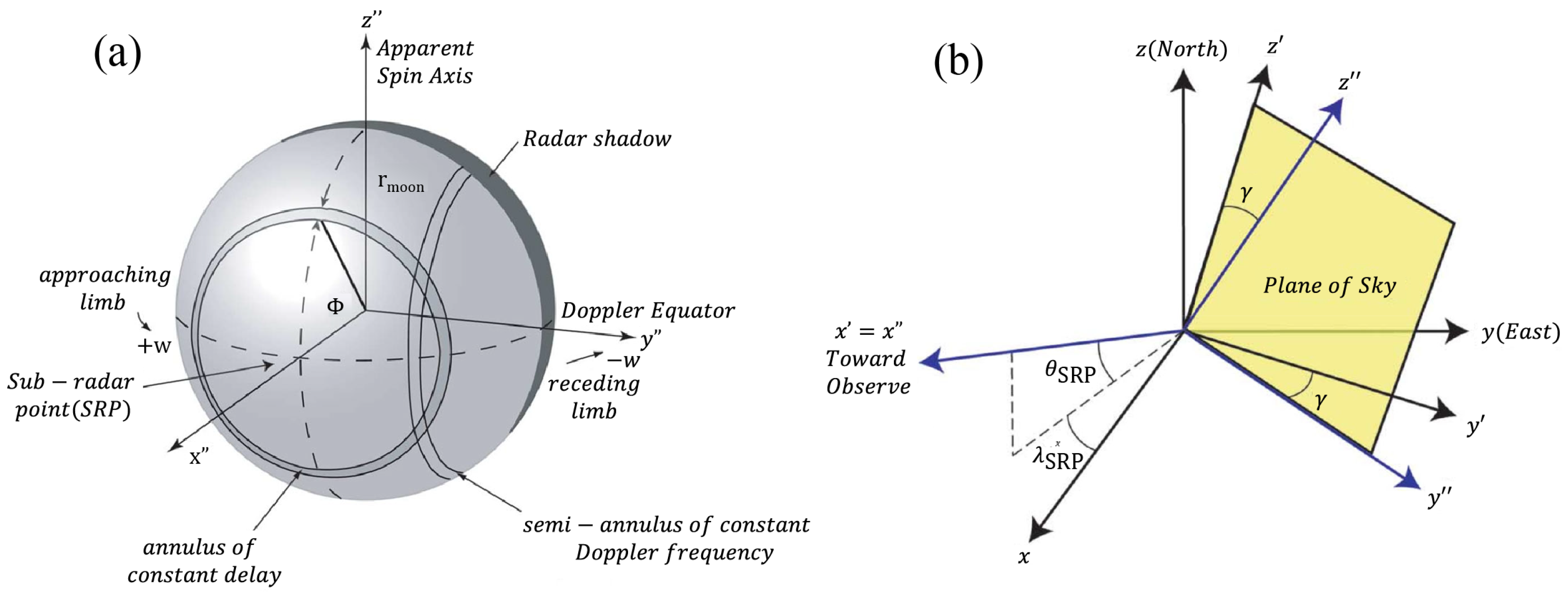

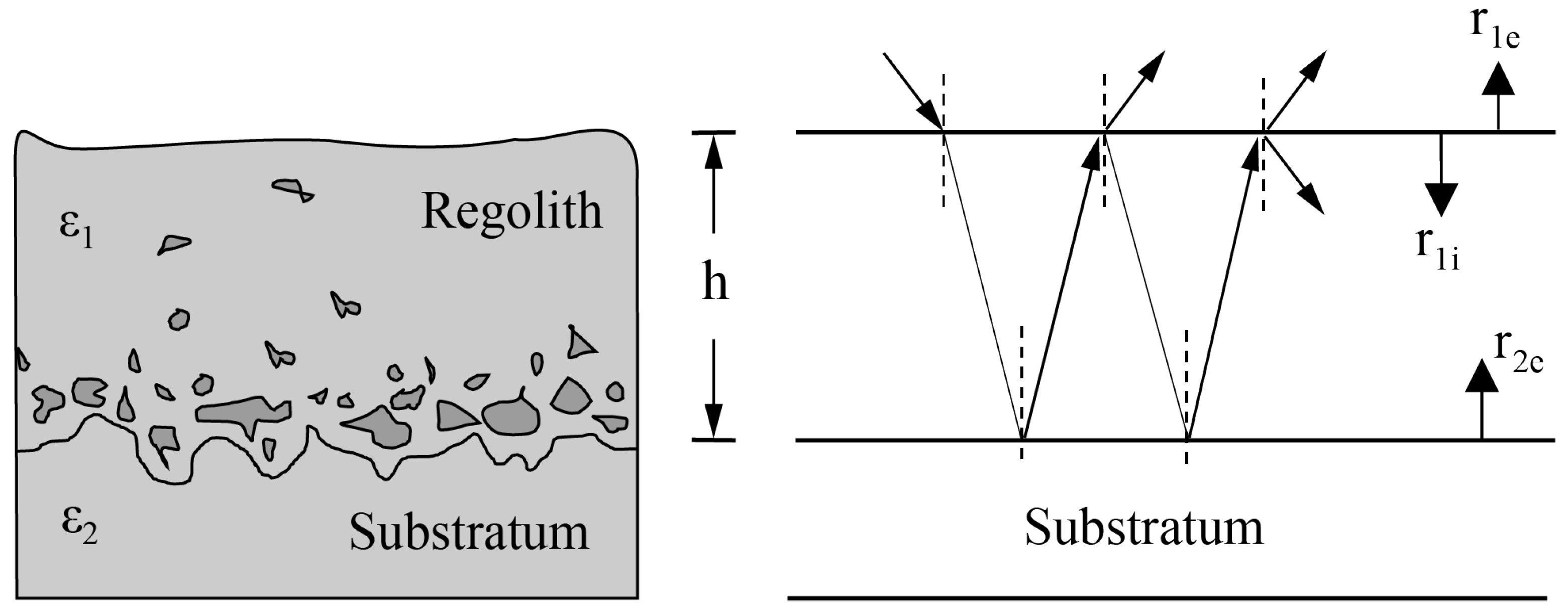
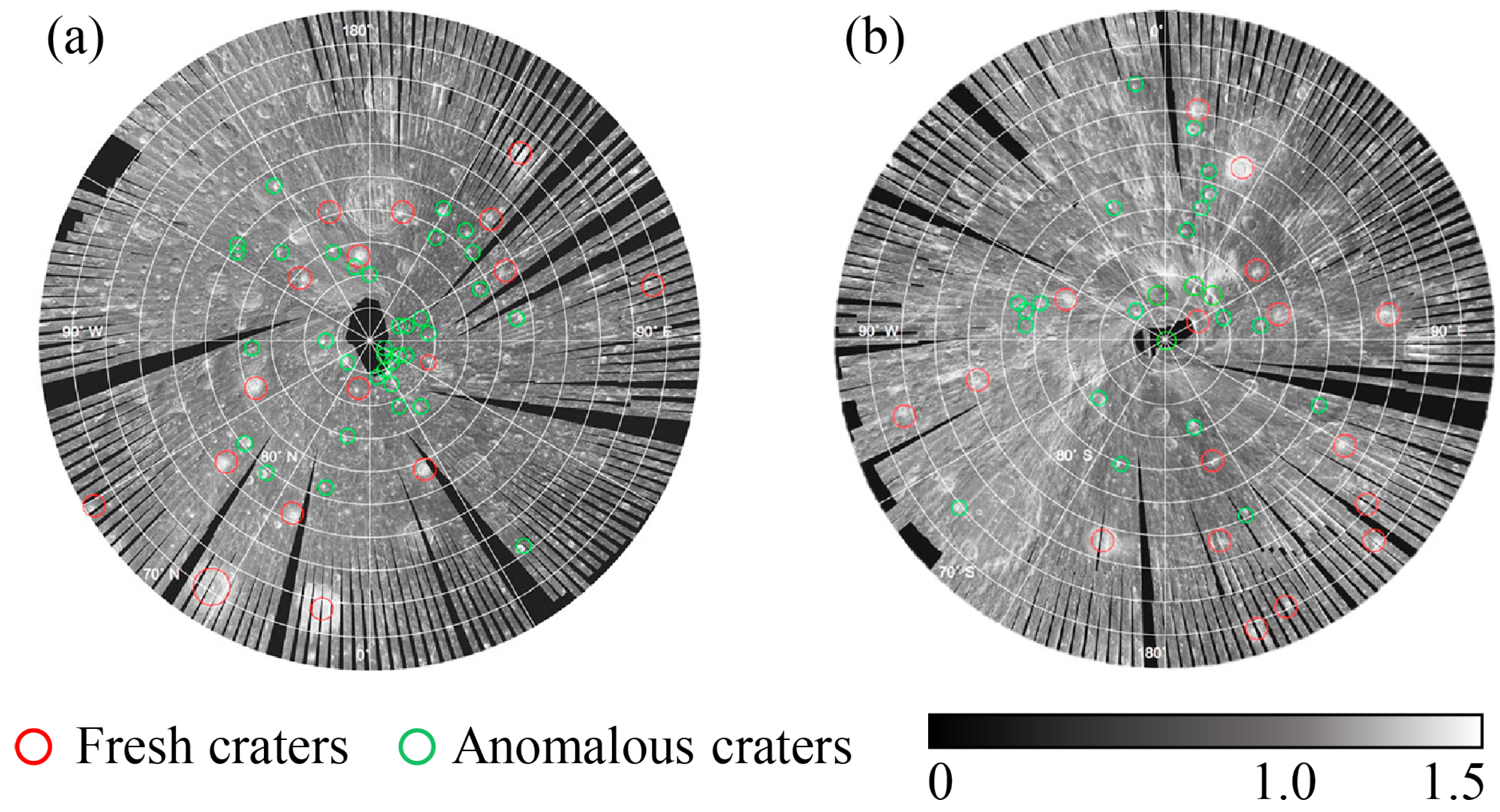
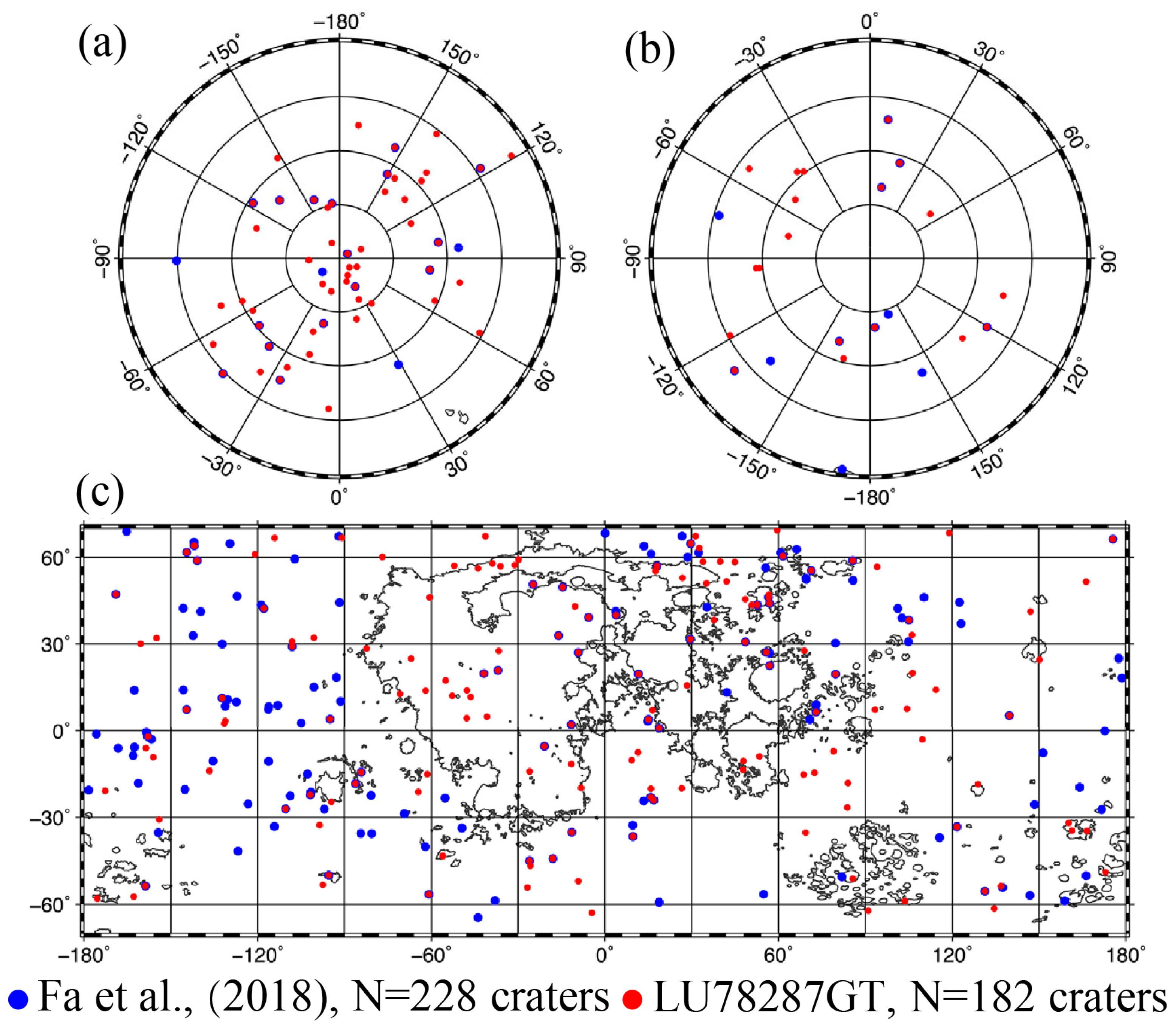
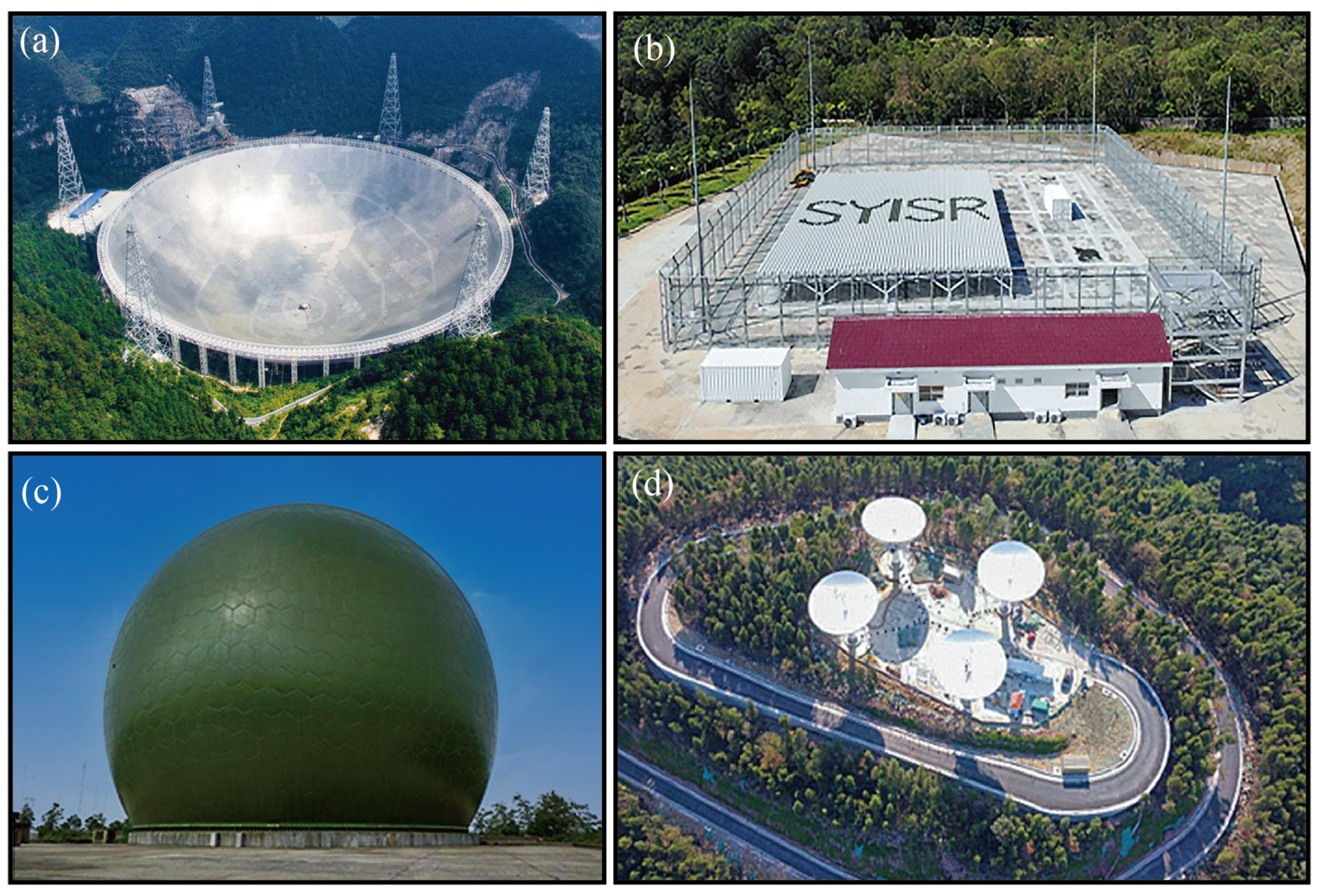
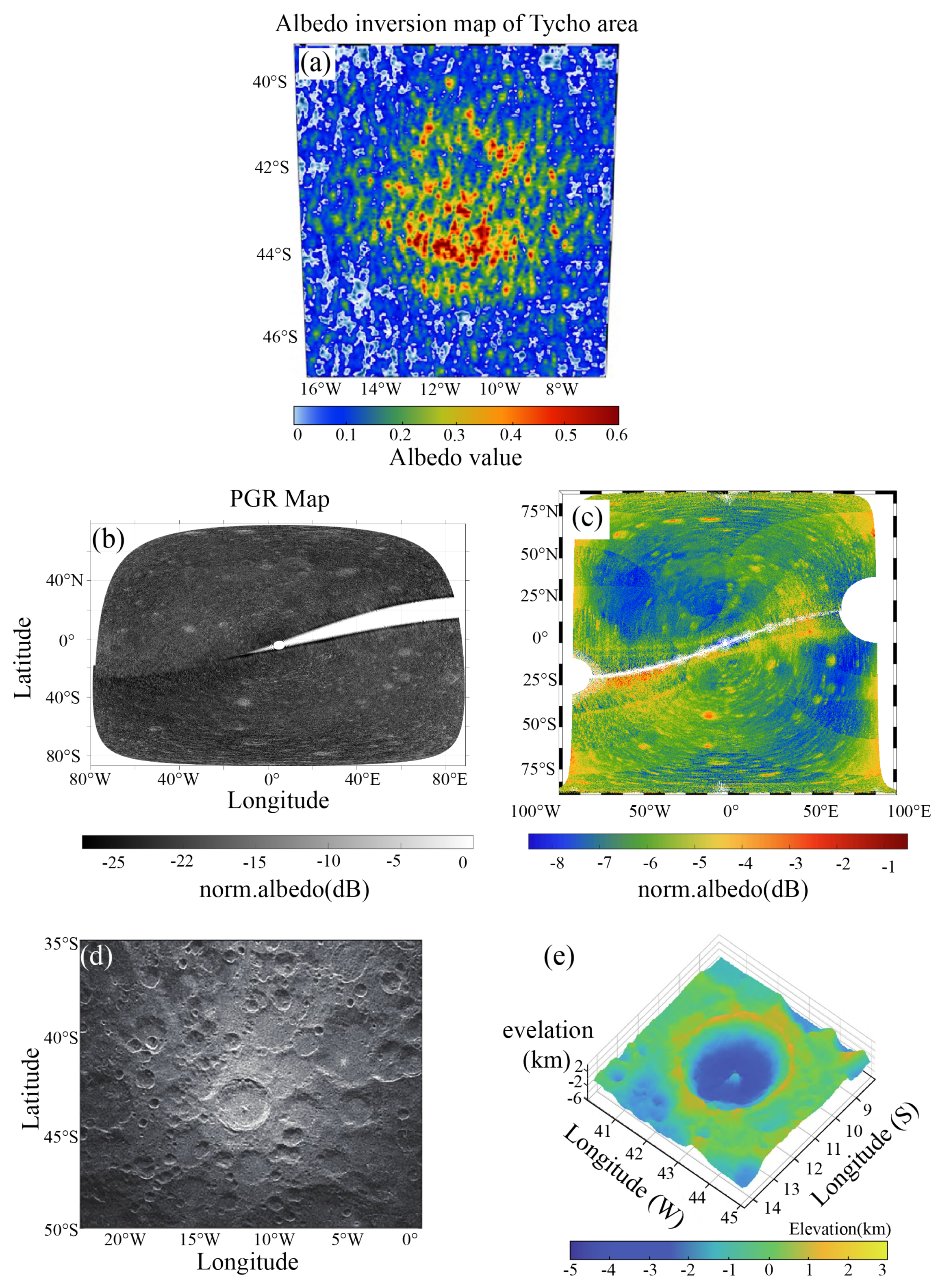
| SAR Instrument | Country | Frequency (GHz) | Polarization | Resolution | Reference |
|---|---|---|---|---|---|
| Mini-SAR | India | 2.38 | Hybrid-pol | 86 m | Goswami et al. [132] |
| Mini-RF | America | 2.38 7.14 | Hybrid-pol | 15–150 m | Nozette et al. [133] |
| DF-SAR | India | 1.25 2.5 | Single dual hybrid-pol quad-pol | 2–75 m | Putrevu et al. [134] |
| CE-7 SAR | China | 1.3 16.7 | Single, dual hybrid-pol quad-pol | 0.3 m/1 m | [135] |
| GBR System | Diameter (m) | Frequency Band |
|---|---|---|
| SYISR | 778 (phased array) | UHF |
| QJISR | 29 | UHF |
| China Compound Eye (Phase I) | 16 (4 units) | VHF |
| Kashgar | 18/35 | S/X/ |
| FAST | 500 | 70 MHz–3 GHz |
Disclaimer/Publisher’s Note: The statements, opinions and data contained in all publications are solely those of the individual author(s) and contributor(s) and not of MDPI and/or the editor(s). MDPI and/or the editor(s) disclaim responsibility for any injury to people or property resulting from any ideas, methods, instructions or products referred to in the content. |
© 2024 by the authors. Licensee MDPI, Basel, Switzerland. This article is an open access article distributed under the terms and conditions of the Creative Commons Attribution (CC BY) license (https://creativecommons.org/licenses/by/4.0/).
Share and Cite
Xu, J.; Ding, C.; Su, Y.; Ding, Z.; Yang, S.; Li, J.; Dong, Z.; Sharma, R.; Qiu, X.; Lei, Z.; et al. Lunar Exploration Based on Ground-Based Radar: Current Research Progress and Future Prospects. Remote Sens. 2024, 16, 3484. https://doi.org/10.3390/rs16183484
Xu J, Ding C, Su Y, Ding Z, Yang S, Li J, Dong Z, Sharma R, Qiu X, Lei Z, et al. Lunar Exploration Based on Ground-Based Radar: Current Research Progress and Future Prospects. Remote Sensing. 2024; 16(18):3484. https://doi.org/10.3390/rs16183484
Chicago/Turabian StyleXu, Jiangwan, Chunyu Ding, Yan Su, Zonghua Ding, Song Yang, Jiawei Li, Zehua Dong, Ravi Sharma, Xiaohang Qiu, Zhonghan Lei, and et al. 2024. "Lunar Exploration Based on Ground-Based Radar: Current Research Progress and Future Prospects" Remote Sensing 16, no. 18: 3484. https://doi.org/10.3390/rs16183484
APA StyleXu, J., Ding, C., Su, Y., Ding, Z., Yang, S., Li, J., Dong, Z., Sharma, R., Qiu, X., Lei, Z., Chen, H., Jiang, C., Chen, W., Cheng, Q., & Liang, Z. (2024). Lunar Exploration Based on Ground-Based Radar: Current Research Progress and Future Prospects. Remote Sensing, 16(18), 3484. https://doi.org/10.3390/rs16183484







